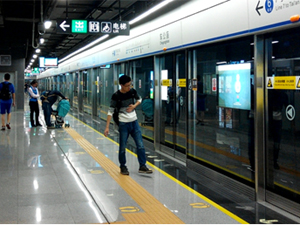



Date:18/03/19
 Scanning your face on a screen to get into the subway might not be that far off in the future. In China’s tech capital, Shenzhen, a local subway operator is testing facial recognition subway access, powered by a 5G network, as spotted by the South China Morning Post.
Scanning your face on a screen to get into the subway might not be that far off in the future. In China’s tech capital, Shenzhen, a local subway operator is testing facial recognition subway access, powered by a 5G network, as spotted by the South China Morning Post.
The trial is limited to a single station thus far, and it’s not immediately clear how this will work for twins or lookalikes. People entering the station can scan their faces on the screen where they would normally have tapped their phones or subway cards. Their fare then gets automatically deducted from their linked accounts. They will need to have registered their facial data beforehand and linked a payment method to their subway account.
There are some advantages to the system. For example, riders won’t have to worry about forgetting their subway card or a low balance, but at the same time, it likely means that their every journey into the subway will be tracked down to the pixels of their faces. It’s not clear if that’s any more tracking than what’s already been done. Many major Chinese cities have extensive surveillance camera systems that log citizens’ faces, ages, genders, and how long they’ve been staying in the area.
The algorithms for the facial recognition tech were designed in a lab overseen by Shenzhen Metro and phone maker Huawei. Shenzhen Metro hasn’t given a timeline for when facial recognition could reach all of its stations and subway lines.
Using facial recognition for payments isn’t new, although using it on subways is. At KFC stores across China, people can scan their face to buy fried chicken, which has been around since 2017.
China is ahead of the US when it comes to mobile payments, as nearly half of the country used their phones to make payments in 2018. Payments made through WeChat Pay or Alipay were so popular that China’s central bank had to warn stores last year not to reject cash or face unspecified penalties. Still, on one occasion when I was in China last year, a shop could not accept cash because it didn’t have enough bills in its coffers to make proper change.
A Chinese subway is experimenting with facial recognition to pay for fares
 Scanning your face on a screen to get into the subway might not be that far off in the future. In China’s tech capital, Shenzhen, a local subway operator is testing facial recognition subway access, powered by a 5G network, as spotted by the South China Morning Post.
Scanning your face on a screen to get into the subway might not be that far off in the future. In China’s tech capital, Shenzhen, a local subway operator is testing facial recognition subway access, powered by a 5G network, as spotted by the South China Morning Post.The trial is limited to a single station thus far, and it’s not immediately clear how this will work for twins or lookalikes. People entering the station can scan their faces on the screen where they would normally have tapped their phones or subway cards. Their fare then gets automatically deducted from their linked accounts. They will need to have registered their facial data beforehand and linked a payment method to their subway account.
There are some advantages to the system. For example, riders won’t have to worry about forgetting their subway card or a low balance, but at the same time, it likely means that their every journey into the subway will be tracked down to the pixels of their faces. It’s not clear if that’s any more tracking than what’s already been done. Many major Chinese cities have extensive surveillance camera systems that log citizens’ faces, ages, genders, and how long they’ve been staying in the area.
The algorithms for the facial recognition tech were designed in a lab overseen by Shenzhen Metro and phone maker Huawei. Shenzhen Metro hasn’t given a timeline for when facial recognition could reach all of its stations and subway lines.
Using facial recognition for payments isn’t new, although using it on subways is. At KFC stores across China, people can scan their face to buy fried chicken, which has been around since 2017.
China is ahead of the US when it comes to mobile payments, as nearly half of the country used their phones to make payments in 2018. Payments made through WeChat Pay or Alipay were so popular that China’s central bank had to warn stores last year not to reject cash or face unspecified penalties. Still, on one occasion when I was in China last year, a shop could not accept cash because it didn’t have enough bills in its coffers to make proper change.
Views: 564
©ictnews.az. All rights reserved.Similar news
- Azerbaijani project to monitor disease via mobile phones
- Innovative educational system to be improved under presidential decree
- NTRC prolongs license of two TV and radio organizations for 6 years
- Azerbaijan establishes e-registry for medicines
- Azerbaijani museum introduces e-guide
- Nar Mobile opens “Nar Dunyasi” sales and service center in Siyazan city
- International conference on custom electronic services held in Baku
- OIC secretary general to attend COMSTECH meeting in Baku
- Azerbaijan develops earthquake warning system
- New law to regulate transition to digital broadcasting in Azerbaijan
- Azerbaijani State Social Protection Fund introduces electronic digital signature
- Intellectual traffic management system in Baku to be commissioned in December
- Tax Ministry of Azerbaijan started receiving video-addresses
- World Bank recommends Azerbaijan to speed up e-service introduction in real estate
- Azerbaijan to shift to electronic registration of real estate





















